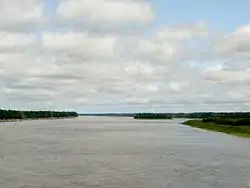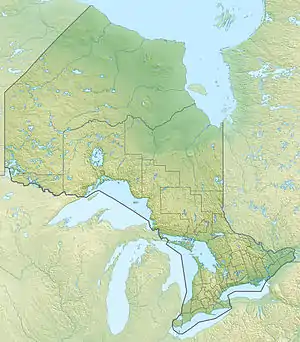Moose River (Ontario)
The Moose River is a river in the Hudson Plains ecozone of northern Ontario, Canada. The river flows 100 km northeast from the junction of the Mattagami and Missinaibi Rivers into James Bay. Its drainage basin is 108,500 square kilometres (41,900 sq mi) and it has a mean discharge rate of 1,370 cubic metres (48,000 cu ft). Its full length is 547 kilometres (340 mi) if counted from the head of the Mattagami River.[1]
| Moose River | |
|---|---|
 Moose River as seen from the ONR railway bridge | |
 Location of the mouth of the Moose River in Ontario. | |
| Location | |
| Country | Canada |
| Province | Ontario |
| District | Cochrane |
| Physical characteristics | |
| Source confluence | Mattagami and Missinaibi Rivers |
| • location | Unnamed wilderness of Unorg. Cochrane District |
| • coordinates | 50°44′08″N 81°28′02″W |
| Mouth | James Bay |
• location | 17 km NE from Moosonee |
• coordinates | 51°21′02″N 80°23′57″W |
| Length | 104 km (65 mi)[1] |
| Basin size | 108,500 km2 (41,900 sq mi)[1] |
| Discharge | |
| • average | 1,370 m3/s (48,000 cu ft/s)[1] |
This river formed part of the water route to Lake Superior in the days of the fur trade. Moose Factory, located on Moose Factory Island near the river's mouth, was a fur trading post of the Hudson's Bay Company and Ontario's first English settlement. Moosonee, on the north bank of the river, is the northern terminus of the Polar Bear Express railway route which begins at Cochrane, Ontario.
Tributaries
The tributaries of this river include:
- North French River
- Kwetabohigan River
- Chimahagan River
- Abitibi River
- Cheepash River
- Renison River
- Mattagami River
- Missinaibi River
- Brunswick River
- Fire River
- Hay River
- Mattawitchewan River
- Albany Forks
- Oba River, Oba Lake
- Albany Forks
- Pivabiska River
- Opasatika River
- Soweska River
Moose River Bird Sanctuary
Moose River Bird Sanctuary lies at the mouth of the Moose River and comprises Ship Sands Island and a piece of land on the eastern flats of the river mouth. The 14.60 km2 sanctuary is protected under the Migratory Birds Convention Act and is part of the Southern James Bay wetland complex, which was designated a wetland of international importance (Ramsar Convention) in May 1987.
This area plays a significant role in the annual cycle of waterfowl. The funnel-shaped outline of Hudson and James bays causes birds migrating from the Arctic to concentrate at the southern end of James Bay each autumn, particularly in the late autumn, where the extensive coastal wetlands provide critical staging and moulting areas for migrating lesser snow geese, dabbling ducks and shorebirds such as red knot, short-billed dowitcher, dunlin, greater yellowlegs, lesser yellowlegs, ruddy turnstone, and American golden plover.[2]
Settlement of Moose River
At mile 142 of the Polar Bear Express railway route there is a small settlement called Moose River. This settlement is just before a large railway bridge that crosses Moose River and is a flag stop on the Polar Bear Express rail route. There is an Ontario Northland Railway bunkhouse that used to be a school. The Moose River bridge was built in the 1930s and the settlement was a much larger community at that time. Currently the Moose River stop at mile 142 is used for the residents of the settlement and as a pick-up and drop-off site for boaters.